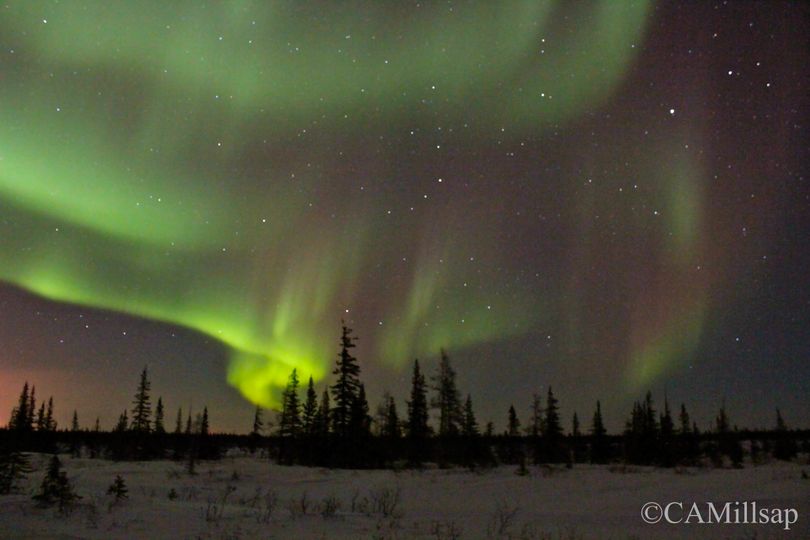Travel: Northern Lights over Churchill, Manitoba

I had three nights and three tries to see and photograph the Northern Lights over Churchill, Manitoba.
The first night, after flying in to the small airport on the edge of Hudson Bay and checking into the Tundra Hotel, after dinner in one of the two restaurants open during the winter season, we climbed into the massive Frontiers North Tundra Buggy, the vehicle that carries tourists close to the polar bears that overtake the little town each fall. We lumbered out onto the frozen Churchill river, navigating around massive tidal hummocks and drifts of deep snow.
Finally, at the edge of the wide, bare, tundra we stopped. The Northern Lights were already spreading across the sky just above the horizon, shapeshifting slowly, almost imperceptibly changing from swirls to vertical streaks to a wide arc overhead. We quickly gathered our gear and rushed out of the buggy, leaving the warmth of the two big propane heaters, and stepped out into the frigid March night.
The air was as clear and sharp as glass.
My gloved hands fumbled over the controls of my camera and when I freed them to adjust the settings and touched the frozen metal of my tripod, the tips of my fingers burned. My breath instantly froze in my nose and in the scarf around my neck. Even layered in fleece and wool and heavy boots, my toes began to chill and ache but I didn’t want to give in. My eyes watered, making it hard to focus through my viewfinder, but I kept pushing the shutter as the lights shifted, moved and teased. They faded and then returned, growing stronger then disappearing only to reappear in another place.
There were others on the ice nearby, hunched over their tripods or gazing up at the sky, but the silence was broken only by the sound of our footsteps on crusted snow that crunched with a peculiar dry, hollow, sound. The deep darkness separated us with more than distance and we didn’t just watch the lights, we were immersed in the experience. But finally, at 2 a.m., when it seemed as though the show was over for the night and we were growing slow and clumsy with fatigue and cold, we surrendered, packed up our gear and climbed back into the warmth of the big vehicle.
It shouldn’t have been a surprise, nature usually gets the last word, but as though waving farewell, the lights suddenly reappeared and pulled together until they coalesced in the sky directly above our tundra buggy. Someone called out and the group spilled back out into the cold as the lights began to dance above us, weaving and undulating as we tipped up our faces to watch. This time we were unencumbered by heavy cameras and gear. There was nothing to distract us. All we could do was gaze up and exclaim.
The next night was cloudy and dangerously cold--with a windchill of almost 60 below zero--so we stayed in the hotel, trading stories and comparing photos. But the third night the clouds blew away and we loaded up again. The trail over the frozen river had been swept clean by the scouring wind so we headed out-- this time in smaller vans--to a dark road just beyond town.
Doug, our guide, had told me that sometimes the light show begins with a faint glow just over the horizon. Keeping my eyes above a row of tall spruce trees, wiping away the frost where my breath crystalized on the van window, I waited. At first I was sure I’d imagined it, but soon others in the van could see the gathering brightness. The Northern Lights were back. Again, we grabbed our cameras and hopped out into the night.
It was even colder than our first night out but this time it didn’t bother me as much. Perhaps it’s because we were more experienced, better prepared for the cutting wind and bone-deep chill--I’d added a layer and tucked extra handwarmers into my pockets and mittens. Maybe it was because we knew we were running out of time. Our adventure was almost over.
The lights were even more brilliant than they'd been before, painting the sky in wide strokes, streaking down toward the ground like silent fireworks. I pressed the shutter again and again but I’d already decided that whatever kind of photo I brought home with me wouldn’t matter. The real magic had imprinted in me and I knew I would never forget it.
But frozen fingers and all, I did manage to get a few photographs. So I have proof of the adventure and a reward for standing in the dark Manitoba night, tracing the stars with my eyes, watching a cold and distant fire sweep across the sky.
Cheryl-Anne Millsap is a travel writer whose audio essays can be heard on Spokane Public Radio and on public radio stations across the country. She is the author of ‘Home Planet: A Life in Four Seasons’ and can be reached at catmillsap@gmail.com You can read previous ‘Home Planet’ columns at www.spokesman.com/blogs/homeplanet